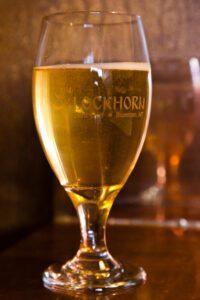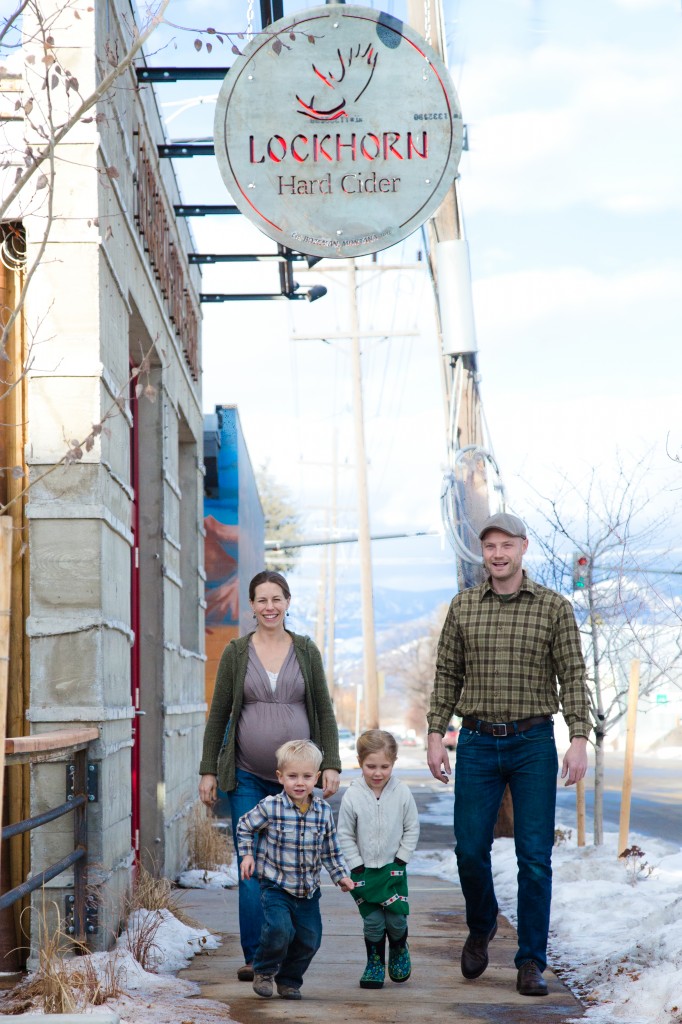By Emily Wolfe Explore Big Sky Managing Editor
BOZEMAN – At midnight on a Wednesday during the December cold snap, a truck carrying 8,000 gallons of organic apple juice from eastern Washington pulled up on Wallace Street in Bozeman, just south of Main.
It was 10 below zero, and after thawing the frozen valves on the truck’s tank, it took five hours to pump the fresh-pressed juice into three, 3,000-gallon tanks at Lockhorn Cider House, a new business fermenting and selling hard cider out of a remodeled building just south of Heeb’s East Main Grocery (this process is pictured below at right).
 Owned by Glen and Anna Deal, who moved to Bozeman from Palmer, Alaska in 2011, the cider house is set to open in January, serving patrons out of a tasting room open seven days a week.
Owned by Glen and Anna Deal, who moved to Bozeman from Palmer, Alaska in 2011, the cider house is set to open in January, serving patrons out of a tasting room open seven days a week.
Because the Deals are fermenting fruit to make alcohol, Lockhorn will operate under a winery license. They have four blends in this first batch– apple, black current, hops and ginger – and will serve patrons 14-ounce pours of the bubbly beverages.
The certified organic, gluten- and sulfite-free cider has no added sugar, so unlike most brands available in stores, it’s dry and very tart.
“Because we let our ciders run completely dry, meaning that they ferment completely, leaving no unfermented sugars, the ciders preserve themselves naturally and we do not need to add sulfites or pasteurize like most other cider that you’ll find on the shelf,” said Anna, 34.
It also means the cider continues to age like wine, the flavors improving over time, and that you’re less likely to feel effects the next day, according to Glen, 35, and a graduate of Montana State University.
At 6.9 percent alcohol, the first sip of Lockhorn cider has a bite, but the subtle, complex flavors resonate on the tongue, rather like wine.
_________
Traditionally, apples in the U.S. and Europe were grown solely for cider, not eating, and in 18th and early 19th century America, it was nearly ubiquitous.
“From the average citizen to the founding fathers, nearly every homestead was growing cider apple trees and fermenting their fruit’s juices into hard cider,” wrote New York Cork Report’s cider and spirits editor David Flaherty, in an Oct. 17 story for Nation’s Restaurant News.
Enter the beer-brewing practices of late 19th century German immigrants, and top it off with Prohibition – and the industry fell off a cliff.
 “Axes were wielded, and cider apple trees – no longer viable, as their fruit was too tannic and acidic for eating off the branch – were felled by the thousands,” Flaherty said.
“Axes were wielded, and cider apple trees – no longer viable, as their fruit was too tannic and acidic for eating off the branch – were felled by the thousands,” Flaherty said.
Now American cider is back, and taking a cue from Europe’s varietals – the English are often dry and tannic, the French sweeter, and Spanish tart – it’s all about the apples, and the best are rooted to a region, even an orchard.
Flaherty noted that, although still a niche industry, domestic hard cider sales tripled from 2007-2012, reaching about $600 million, citing market-analyst firm IBISWorld.
And downtown Bozeman now has 8,000 gallons of the stuff at its fingertips.
After the midnight delivery, the Deals brought the juice in the fermenting tanks up to 60 degrees, and then added rehydrated yeast and small amounts of organic nutrient.
 Next, it was a matter of controlling the temperature during fermentation – the process generates heat that can disrupt flavor – and monitoring for healthy fermentation with a hydrometer, which measures the specific gravity of liquids, indicating the concentration of sugars. After two weeks, the hydrometer measured zero (pictured here).
Next, it was a matter of controlling the temperature during fermentation – the process generates heat that can disrupt flavor – and monitoring for healthy fermentation with a hydrometer, which measures the specific gravity of liquids, indicating the concentration of sugars. After two weeks, the hydrometer measured zero (pictured here).
“Most ciders have a bit of sugar either added on the back end, or they stop fermentation early,” Glen explained. “Sugar is a flavor enhancer, [but] we’re avoiding that because we don’t want to add carbohydrate to our alcohol.”
During one step – agitating the nutrient and yeast, or ‘lees’ – he accidently let too much pressurized oxygen into one of the tanks, causing it to bubble over. “It shot a geyser [of cider] that hit the ceiling,” he recalls, laughing.
After two weeks, the Deals began the process of cold stabilization – lowering the temperature in the tanks to 40 degrees, which forces the lees to precipitate from the liquid and settle to the bottom, aiding in the clarification process.
As of press time, they were waiting on this step so they could pump the clear beverage into another tank – a process called ‘racking’ – and then add carbonation for a finished sparkling hard cider.
________
Built in 1967, the structure that houses Lockhorn was previously a nondescript gray cinderblock garage.
With Glen acting as general contractor, the Deals used a tight group of local subcontractors to design and build what Anna – whose previous job was as an environmental consultant – called “a 200-year structure, versus a 20-year structure.”
The resulting two-story, 1,700-square-foot space is “… probably the most energy efficient building in the state,” according to Mike McPherson of Comfort Engineering, who installed Lockhorn’s high-efficiency HVAC and refrigeration systems, radiant floor heat, and consulted on its exterior insulation.
The 19-inch walls have an R-value of R60, the ceiling R86. “On commercial buildings, no one does that,” McPherson said.
“Knowing we were going into what could be considered an energy intensive business, I was adamant about making sure we had plenty of insulation,” Glen said. “Especially with the hot summers, we don’t want to be completely dependent on air conditioning.”
An addition brought the tasting room within a foot of the sidewalk on Wallace.
“The city actually encouraged us to bring the tasting room as close to the sidewalk as possible, to really celebrate the pedestrian nature of that,” said architect Thor Arnold. “Trying to bring a little bit more of an urban feel to that part of town over time.”
 A glass wall on the south side opens to a patio, “not unlike a German beer garden, where it’s a little bit outside and inside,” Arnold said.
A glass wall on the south side opens to a patio, “not unlike a German beer garden, where it’s a little bit outside and inside,” Arnold said.
Glen (pictured at right with Anna and children Alder and Oden) demoed as little as he could get away with during the remodel, adding insulation to many of the cinder block walls and repurposing materials like old fir floor joists and rafters, which became benches, wainscoting, doors and table tops.
_________
The interior space – which screams laid-back Bozeman chic, or “refined industrial,” as Glen describes it – indeed feels welcoming. Local art and photography hangs on the walls, and the Deals are there behind the bar, smiling, telling stories and filling glasses.
Lockhorn is considering a limited food offering, and will have cider available by the pint and growler, as well as wholesale in kegs for local bars and restaurants. Later this year, the Deals plan to sell it in bottles, offering a refund for returns.
Further out, they say, the dream is to have an orchard, where they can grow their own cider varietals. For now, though, the goal is for Lockhorn to be a relaxed gathering place, Glen says. “We want it to have sort of a quaint pub feel.”
Lockhorn Cider House will be open seven days a week from 4 – 10 p.m., and 4-midnight on Fridays and Saturdays.













